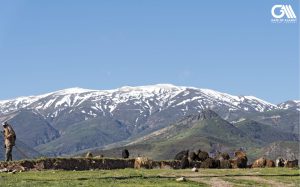Introduction to the history of the Hashashin (Hashishiyin) of Alamut in Iran
Once upon a time, in the 11th century, Iran was under the domination of Arabs and the Arab Khalifah (king/leader) was ruling a large section of the old Persian territory.
Like many other governments, the Muslim Arabs started their state with a lot of mercy and good behavior towards people, and apparently, people were happily living. But as time went by, gradually the rulers started a change in their policy about governing people. Here came the misusing of the power and the highly economical access to which they were in charge. Hashashin (Hashishiyin) of Alamut in Iran
Film: JohnWick 3
When the leader of the assassins refers to themselves as the descendants of Hasan, implying to Hasan-i-Sabah, the first leader of the assassins.
Unlike the beginning of their government, cruelty lost its obscenity. The authorities surrounding the Khalifah had no limit in using their power against the common people.
As a result of suppressing people for a long time, gradually some secrets movements started to grow.
At the time, the religion of Islam and its different sects was the main tool for the common people to get into groups and get united.
A shepherd and his sheep in the Valley of the Assassins[/caption]
FLASHBACK: One of the sects of Islam that was getting more and more strong with many followers outside of Iran was the sect Ismaili or the Seveners.
Who were the Ismailis?
Back in the old times, when the prophet Mohammad died, there began a lot of conflict on who is going to be the successor of the leadership. Since according to Quran he was the last prophet, people didn’t expect another prophet but still, they needed a religious/political leader.
After the prophet Mohammad, some people believed that the leadership must remain in his direct family and no one else can inherit this stand. So they tend to follow the “Sunnat” which means the tradition and the way the prophet lived. With this belief, Abo-Bakr who was the father-in-law of the prophet was chosen by some people and the Sunni sect was founded.
On the other hand, some Muslims believed that the prophet during his last pilgrimage to Mecca had officially announced that Ali (his son-in-law) would be the next leader as we call: Imam.
Imam means the leader, the forerunner, the pioneer, or the pathfinder. These followers officially founded Shiite Islam. “Shiia” means “follower”.
Time went by and Sunnite and Shiite started to have their own different sects.
One of the main sects of Shiite Islam is the Twelvers. At this belief, there are 12 Imams the first of which was Ali.
Another sect of Shiite Islam was Ismailis. Unlike the Twelvers, the Ismailis believed that the 6th Imam did not choose Kazem as the next Imam. He chose Ismail who was his older son.
Due to the mal-behavior of the Khalifah in Baghdad (Iraq), many secret movements and rebels started. One of the serious ones was managed by the Ismailis.
The movement started in Egypt, under the name of “Fatemiyoon”.
There was this Imam after Ismail, who had many connections to expand his ideology.
One of the highest-ranking connections and more of a missionary in Fatimiyoon of the Ismailis was Hasan-e-Sabbah.

Hasan, a genius student of religion, mathematics, and philosophy, got a chance to announce independence from the leaders in Egypt.
He had this ideology that he is the special envoy of the leader in Egypt.
Then he started to gather and gain many followers. From common farmers in the farms of Alamut to high-ranking authorities in the government of the time which was Seljuk.
For the first years of his invitation to the Ismaili religion, he had no stable base. Some time in Northern Iran, some in Northeast in Khorasan region.
But as time goes on, he gained more and more followers that believed in him. Then he thought of having a stable base. Since he was sort of dominant in the whole country and he knew that the government will send after him soon or late, he planned to choose a spot that will remain safe from the enemies.
At that time, the castle of Alamut was under the control of the Seljuk king from the central government. For many years he had this castle in mind to catch and turn into his headquarters. Finally, with the help of his messengers who had made connections with the guards of the castle, he could enter the castle and start his governing.
Hasan needed a strong tool to unite and to teach his soldiers and his followers. What can be more powerful than religion and beliefs?
He taught his soldiers the main ideas of the religion and the fact that if they were killed they will go the heaven as martyrs.
On the other hand, there were two persons who were unhappy about Hassan getting this much power and this many followers, the Khalifeh in Baghdad and the Sejuk king in central government.
Hasan started to make and occupy more and more castles in Alamut Valley and later expanded the territory to a vast majority of Iran, from Sistan to Qom, Alamut Valley, and Khorasan.
Logically, Hasan did not have a big army to fight with his rivals face-to-face. He came up with the idea of the assassination.
He was training soldiers for many years to make them ready for a mission; a mission in which he ordered them to assassinate an authority from the opposition.
The assassins never attacked women and children and their willingness was to kill only the high-ranking authorities, to make the opposition party afraid and let the Ismailis do their job.
The Khalifah being terrified of the ongoing power of the assassins in Iran started a rumor.
“Hasan offers hashish to his soldiers to make them high, to make them assassinate the people. “
The rumor went even more. The leader has a hidden garden (hidden paradise) full of young maidens and wine prepared everywhere. When he wants to send a soldier to assassinate a target, he offers the hidden garden to them. They were free in having wine and having maidens for some days. Then he turned them into real life, telling them: if you want that paradise again, you have to assassinate that target. If you succeed, and you were back alive, I will offer you my paradise again. But if they kill you in this mission, don`t worry, you will be a martyr and, you will go into the eternal paradise.
No one is sure if the rumors were true or not but the legend remains as untouched.
But what we are sure of, is the word “assassin” in English, having its origin in Alamut Valley. The people who smoked Hashish and the people called them: Hashishiyin. Later the pronunciation and the meaning changed to “assassins”.
The Ismailis were “the most effective terrorist group in history”. Freya Stark, “The Valley of the Assassins”.
In another, (more realistic) point of view, Hashish had a meaning of “herbal medicine”. Hashashin were the people who sold herbal medicine, i.e hashish.
If you travel to Alamut, you will notice the locals are picking some herbs in the mountains. Those have different usages as for cooking, salad or herbal medicine.
At the time, Alamut was the connecting point of Qazvin (southern slope of Alborz) and Caspian sea (northern slope).

From different document like the elderly locals in the valley and the caravansary in Picheh Bon, we can come to this conclusion that Alamut valley was the commercial connecting point at the time.
The Assassins were able to rule over a considerable zone in Peria with their mysterious system for 185 years.
When was the end of Hashishiyeh in Alamut?
In 1256 Hulegu Khan (the grandson of Changiz Khan) sieges the castles of the Assassins, one by one and took them over.
They ruined all of the castles so that not another movement could be started on behalf of Ismailis.



Are there any Assassins left?
Yes, the followers of Ismaili religion are still living and that is a minority of Shiaa Islam that still exists in some countries in the world. India, Pakistan, Afghanistan and Africa are the home to most of Ismaili followers. But in many EU countries there are some numbers. The total is estimated about 15 million people in the world.

Aghakhan, the current Imam of Ismailis.


